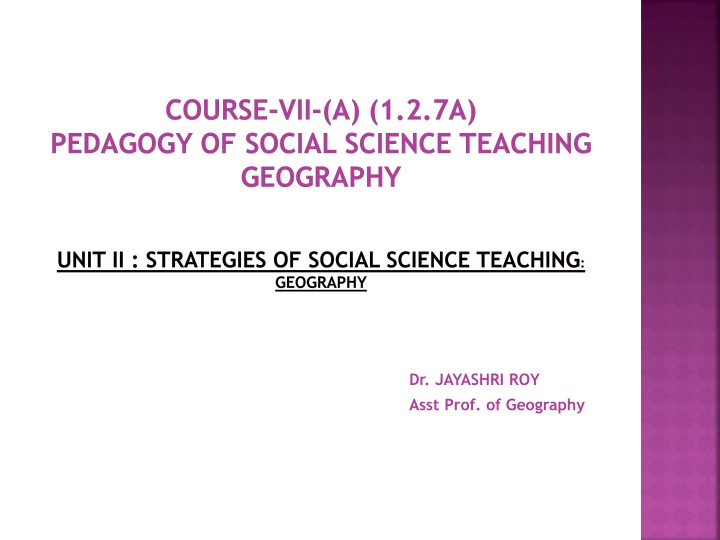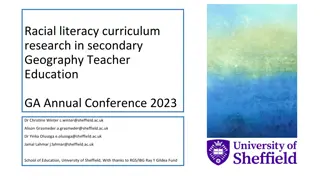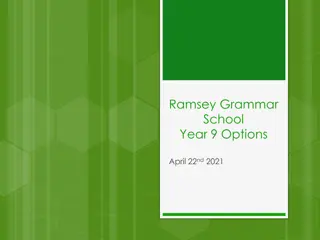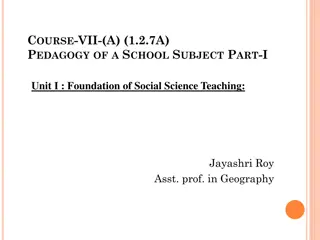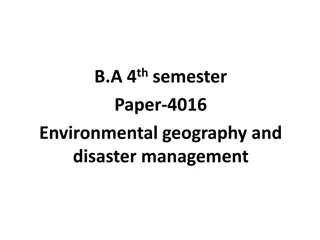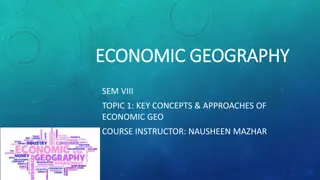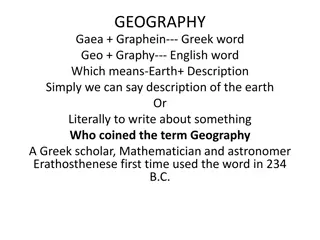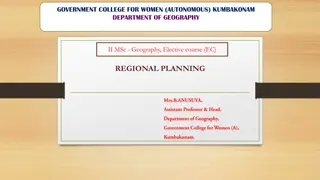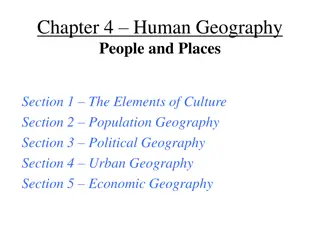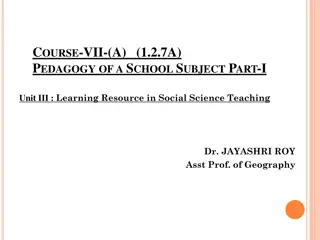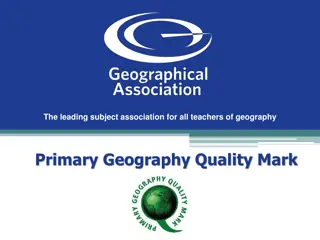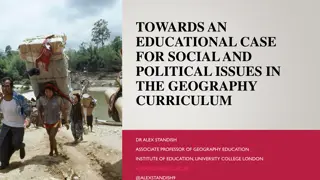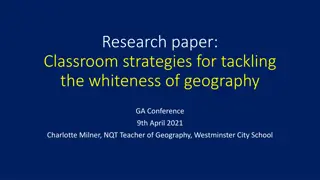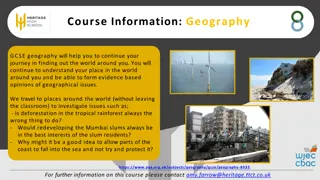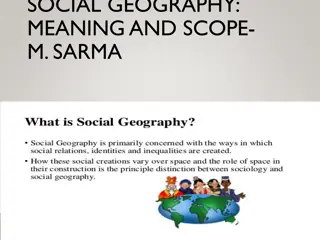Strategies of Teaching Geography in Social Science Education
Social Science education encompasses various disciplines such as history, geography, economics, and sociology. The pedagogy of teaching geography involves linking subject matter with students through methods like lecture, interactive, demonstration, observation, heuristic, project-based, and computer-assisted instruction. The objectives include familiarizing student teachers with different teaching methods, understanding the teacher's role in applying methods, and recognizing the merits and limitations of each approach.
Download Presentation

Please find below an Image/Link to download the presentation.
The content on the website is provided AS IS for your information and personal use only. It may not be sold, licensed, or shared on other websites without obtaining consent from the author.If you encounter any issues during the download, it is possible that the publisher has removed the file from their server.
You are allowed to download the files provided on this website for personal or commercial use, subject to the condition that they are used lawfully. All files are the property of their respective owners.
The content on the website is provided AS IS for your information and personal use only. It may not be sold, licensed, or shared on other websites without obtaining consent from the author.
E N D
Presentation Transcript
COURSE-VII-(A) (1.2.7A) PEDAGOGY OF SOCIAL SCIENCE TEACHING GEOGRAPHY UNIT II : STRATEGIES OF SOCIAL SCIENCE TEACHING: GEOGRAPHY Dr. JAYASHRI ROY Asst Prof. of Geography
INTRODUCTION Social Science is about people and the societies in which they live. It focuses on people as intellectual, spiritual, emotional and social beings, and on how they relate to each other and their environments in local, national and global settings. Social Science also involves learning from the past, investigating the present and considering the future of people and their societies. Social Science draws its content from a range of disciplines, areas of knowledge and fields of learning. In particular, these include: History analysis of cause and effect in human affairs over time Geography decision making in human and environment interactions Economics management of resources for the satisfaction of human wants Consumer Education development of knowledge and decision making skills for exercising consumer choice Politics exercise of choice and decision making by people from amongst policy options Law application of rules and conventions to regulate human behaviour Sociology organization of human society Anthropology investigation of diverse cultures, their contexts, components and interrelationships Social psychology behaviour of people in group settings
STRATEGIES OF SOCIAL SCIENCIES The process by which a teacher establishes link between the subject matter and the pupils is called a method. It is a device adopted by the teacher to give instruction on a particular topic Rusk A method is nothing but a scientific way of presenting the subject matter, keeping in mind the psychological and physical requirements of the children.
TEACHING-LEARNING METHODS IN GEOGRAPHY LECTURE METHOD INTERACTIVE METHOD DEMONSTRATION METHOD OBSERVATION METHOD REGIONAL METHOD HEURISTIC METHOD PROJECT METHOD REGIONAL METHOD COMPUTER ASSISTED INSTRUCTION
OBJECTIVES To familiarize the student teachers with different methods of teaching geography in classroom To develop an understanding the role of a teacher for application of methods in the classroom. To develop an understanding of the merit and limitations of various methods.
LECTURE METHOD Lecture method is the oldest method of teaching. It based on the philosophy This method refers to the explanation of the topic to the students. The emphasis is on the presentation of the content. ... It is the simplest method for teachers and does not require any arrangements. In this teaching method a large amount the topics can be covered in a single class period. Using of this method exclude the using of any equipment or Lab. Learning material is not required. Student listening skills developed. is of idealism.
INTERACTIVE METHOD Interactive teaching is a means of instructing whereby the teachers actively involve the students in their learning process by way of regular teacher-student interaction, use of audio-visuals, and hands-on demonstrations. The students are constantly encouraged to be active participants. In this method Efficient, cheap way of conveying a topic to a large audience Promotes adult learning Easily remembered Improves verbal communication skills Both non-verbal and verbal communication skills are observed Allows for repeated practice and reinforcement of techniques before exposure to patients interaction, student-student
DEMONSTRATION METHOD A method demonstration is a teaching method used to communicate an idea with the aid of visuals such as flip charts, posters, A demonstration is the process of teaching someone how to make or do something in a step-by-step process. As you show how, you tell what you are doing. power point, etc.
OBSERVATION METHOD Psychologist came to know the fact that children possess instinct of curiosity and are curious to see the things for themselves and particularly those things which exist around them. The geographers exploited this fact to their own advantage. A thing observed and a fact discovered by the child for himself his own efforts become a part of mental life of the child. It is certainly more valuable to him than the same fact or facts learnt from the teacher or a book. The principles aspects of observation method are to observe to record to interpret. The technique of obtaining geographical information by direct observation is basis to the subject. Observation method for teaching geography may be used inside the class room as well as outside the class -room. Inside the class-room, the following aids help observation: ( i) Globe : Globe is a useful aid. By observation, children can develops such concepts as longitude ,latitude, meridian etc. (ii) Charts : Charts prepared by children themselves or those commercially produced also enhance children s observation. (iii) Models : Children observe things and they can convert the results of their observation into models. (1) (2) (3) (4)
OBSERVATION OUTSIDE THE CLASS-ROOM Field Trips : Field trips help in exploring the environment .Children may be taken out into the larger landscape to observe geographical objects, prepare brief notes, and collect specimens and so on. Excursions: Excursions educate as well as entertain. Children learn by interacting with the environment. Excursions geographical monuments understand certain phenomena. to hill stations, children to to help
PROJECT METHOD Discussed Prof. Kilpatrick defined a project as a purposeful activity which environment. Dr. J.A Stevenson who perfected it as a method of teaching said it ia a problematic act carried to completion in its natural setting. According to C.V. Good A Project is a significant unit of activity, having educational value and aimed at one or more definite goals of understanding. Basic Principles of Project Method 1. The project must be based on activity-mental or motor. 2. It must be purposeful in its action. 3. Under the project, the children must accumulate experience-manipulative, concrete or mental. 4. It must provide real experience. 5. It must be useful in nature. proceeds in a social
REGIONAL METHOD OF GEOGRAPHY Regional Method of teaching geography is in fact closely related with the method of basing geographical teaching on home geography. Major Natural Regions of the world The latest classification of the major natural regions of the world is given below A-Tropical Belt. The Equatorial Region (2) The Monsoon Region (3) The Hot Deserts (4) The Sudan Type Region B- Warm Temperate Belt (1) The china Type Region (2) The Mediterranean Region (3) The steppes or Turan Type Region C- Cool Temperate Belt (1) The Manchurian Type or St. hawrence Type Region. (2) The North west European Type Region (3) The prairre Region D-Cold Belt (1) The Taiga Forests (2) The Tundras (3) The Iu caps
DISCUSSION METHOD 1.Emphasis on Learning instead of Teaching, Discussion Method emphasizes pupil-activity in the form of discussion, rather than simply telling and lecturing by the teacher. Thus, this method is more effective. 2. Participation by Everybody. In this method, everybody participates in the discussion , and therefore thinks and expresses himself .This is a sure way of learning. 3. Development of Democratic way of Thinking Everybody cooperates in the discussion, and the ideas and opinions of everybody are respected. Thus, there is a development of democratic way of thinking and arriving at decision.
COMPUTER ASSISTED INSTRUCTION When computer is used as an aid to teaching method of instruction is called computer assisted instruction.
CONCLUSION There are many teaching methods and resources available to Social science teachers. The methods among others include simulation methods which include simulation activities and simulation games: laboratory method which involves the employment of source materials; audio-visual aids and other lifelike activities to supplement textbook instructions. Others include inquiries, projects, demonstration, question and answer, field-trip, discussion, lecturer, problem- solving methods etc. It should however, be noted that no single methods of teaching Social Studies can adequately fill all learning combination of other methods would definitely help in achieving the desired instructional objectives. situations. The
REFERENCES 1.Dasgupta, J. & Mete,J. (2018). pedagogy of social science teaching (Geography). Aaheli publishers : Kolkata 2.Thakur Chakravorty, M. & Roy, P. (2018-2019) pedagogy of social science teaching (Geography). Rita Book Agency: Kolkata 3. http://www.preservarticles.com
